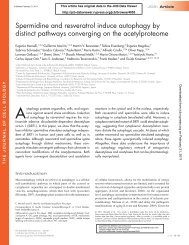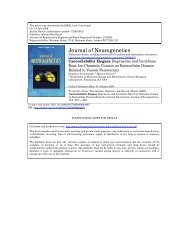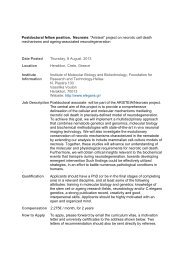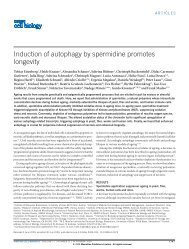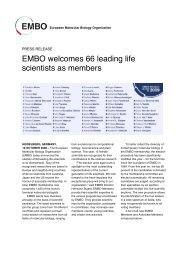CELL BIOLOGY OF THE NEURON Polarity ... - Tavernarakis Lab
CELL BIOLOGY OF THE NEURON Polarity ... - Tavernarakis Lab
CELL BIOLOGY OF THE NEURON Polarity ... - Tavernarakis Lab
Create successful ePaper yourself
Turn your PDF publications into a flip-book with our unique Google optimized e-Paper software.
Cell Biology of the Neuron: <strong>Polarity</strong>, Plasticity and Regeneration, Crete 2011<br />
Defining Roles of PKMzeta in AMPA Receptor<br />
Trafficking<br />
Ellen Barker 1 , Jeremy Henley<br />
1 University of Bristol<br />
Synaptic plasticity, the modulation of communication efficacy at synapses shapes<br />
the neural networks thought to encode memories. Long term potentiation (LTP),<br />
the persistent enhancement in synaptic communication, is one such type of<br />
plasticity. LTP has two main mechanistically distinct phases, an induction (early)<br />
and a maintenance (late) phase (E-LTP, L-LTP) thought to be analogous to the<br />
processes of initial learning and long-term memory storage. AMPA receptors<br />
(AMPAR) mediate the majority of fast excitatory transmission in the brain, so<br />
changes in their expression at synapses underlie synaptic plasticity, with an<br />
increase in AMPAR number or conductivity leading to LTP. A brain-specific<br />
atypical Protein kinase C isoform, PKMζ has been shown to be both necessary<br />
and sufficient for L-LTP, but not E-LTP. Perfusion of ZIP, a specific inhibitor of<br />
PKMζ into hippocampi of live rats prevents memories of a task persisting beyond<br />
about 10 minutes, and completely erases pre-established memories. As well as<br />
showing PKMζ is a key factor in memory formation; these studies provide<br />
compelling evidence for links between the biphasic models of LTP and of<br />
memory formation. I am interested in the mechanisms of PKMzeta-dependent<br />
AMPAR trafficking on a molecular level using cultured neurons. I show that ZIP<br />
decreases surface expression of GluR2 but not GluR1, although rates of<br />
endocytosis of both are increased. Since GluR1 and GluR2 subunits have distinct<br />
roles and trafficking patterns in E-LTP and L-LTP, I hope to better define the<br />
roles of PKMζ in the context of these phases by characterising endo- and exocytic<br />
events, as well as identifying interactions with other proteins involved.<br />
Presented by: Barker, Ellen<br />
Poster No 004<br />
Red Session<br />
86



